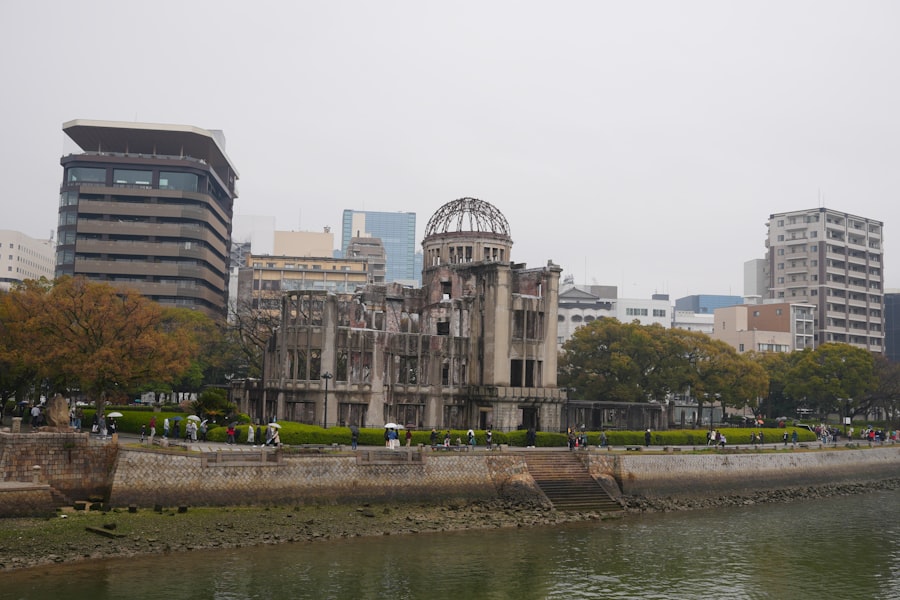The historical context of Germany’s atomic bomb project is rooted in the tumultuous period of World War II, a time when scientific advancements were often intertwined with military ambitions. In the early 20th century, German physicists were at the forefront of nuclear research, with notable figures such as Albert Einstein and Max Planck contributing to the foundational theories of nuclear fission. However, the rise of the Nazi regime in the 1930s shifted the focus of scientific inquiry from pure research to applications that could bolster military power.
The urgency to develop an atomic bomb became apparent after the discovery of nuclear fission in 1938 by Otto Hahn and Fritz Strassmann, which opened the door to the possibility of harnessing atomic energy for destructive purposes. As the war progressed, the German government recognized the potential of nuclear weapons and initiated a series of projects aimed at developing an atomic bomb.
However, despite initial enthusiasm and significant intellectual resources, the project faced numerous challenges that ultimately hindered its success. The historical context of Germany’s atomic bomb project is thus characterized by a combination of scientific ambition, political ideology, and the chaotic realities of wartime resource allocation.
Key Takeaways
- Germany’s atomic bomb project was influenced by the historical context of World War II and the race for nuclear weapons.
- Lack of collaboration and communication among German scientists hindered progress in the atomic bomb project.
- Allied sabotage and espionage further impeded Germany’s atomic bomb program.
- Resource allocation and prioritization of other military projects affected the development of the atomic bomb in Germany.
- Leadership and organizational issues within the German atomic bomb program contributed to its challenges and setbacks.
Lack of Collaboration and Communication Among German Scientists
One of the critical factors that impeded the progress of Germany’s atomic bomb project was the lack of collaboration and communication among its scientists. The scientific community in Germany was fragmented, with various groups working in isolation rather than as a cohesive unit. This disjointed approach was exacerbated by personal rivalries and differing scientific philosophies among key figures.
For instance, while some scientists advocated for a more theoretical approach to nuclear physics, others focused on practical applications, leading to a divergence in research priorities that stymied collective progress. Moreover, the competitive atmosphere fostered by the Nazi regime further complicated collaboration. Scientists were often more concerned with advancing their own careers and gaining favor with the government than with working together towards a common goal.
This lack of unity not only slowed down research efforts but also resulted in duplicated work and wasted resources. The absence of effective communication channels meant that breakthroughs made by one group were not shared with others, leading to missed opportunities for innovation and advancement in nuclear technology.
Allied Sabotage and Espionage

The efforts of Allied forces to sabotage Germany’s atomic bomb project played a significant role in its ultimate failure. From early in the war, Allied intelligence agencies recognized the threat posed by a potential German atomic weapon and took proactive measures to disrupt research efforts. One notable operation was the bombing of heavy water production facilities in Norway, which were crucial for nuclear research.
This strategic sabotage not only delayed German progress but also forced scientists to seek alternative methods and materials, further complicating their efforts. Espionage also played a critical role in undermining Germany’s atomic ambitions. Allied spies infiltrated various scientific institutions and military organizations, gathering intelligence on research developments and sharing it with their respective governments.
This flow of information allowed the Allies to stay one step ahead, anticipating German advancements and countering them effectively. The combination of sabotage and espionage created an environment of uncertainty and fear within German scientific circles, ultimately contributing to the disarray that characterized their atomic bomb project.
Resource Allocation and Prioritization of Other Military Projects
| Project | Allocated Resources | Prioritization |
|---|---|---|
| Project A | 50 personnel, 10 vehicles | High |
| Project B | 20 personnel, 5 vehicles | Medium |
| Project C | 30 personnel, 8 vehicles | Low |
Resource allocation during World War II was a complex issue for Nazi Germany, as competing military projects vied for limited funding and materials. The German leadership prioritized conventional weapons and military operations over nuclear research, viewing them as more immediate threats to their war efforts. As a result, funding for the atomic bomb project was often insufficient, leading to delays and setbacks in research and development.
The focus on other military technologies, such as jet aircraft and advanced artillery, further diverted attention away from nuclear weapons. Additionally, the prioritization of resources was influenced by ideological considerations. The Nazi regime placed a strong emphasis on projects that aligned with its militaristic goals and propaganda efforts.
As a result, many scientists involved in the atomic bomb project found themselves competing for resources against projects deemed more critical to the war effort. This competition not only hampered progress but also created an environment where scientific inquiry was often subordinated to political agendas.
Leadership and Organizational Issues within the German Atomic Bomb Program
Leadership and organizational issues within Germany’s atomic bomb program significantly hindered its effectiveness. The program lacked a clear chain of command and cohesive leadership structure, resulting in confusion and inefficiency. Key figures such as Werner Heisenberg and Otto Hahn had differing visions for the project, leading to internal conflicts that stifled innovation.
The absence of a unified strategy meant that resources were often misallocated or wasted on unproductive lines of inquiry. Furthermore, the bureaucratic nature of the Nazi regime complicated decision-making processes within the scientific community. Scientists were often required to navigate a labyrinthine system of approvals and oversight that slowed down research efforts.
This bureaucratic inertia was particularly detrimental in a field where rapid advancements were crucial for success. As a result, leadership issues within the German atomic bomb program contributed to its inability to compete effectively with Allied efforts.
Challenges in Uranium Enrichment and Nuclear Reactor Technology

The technical challenges associated with uranium enrichment and nuclear reactor technology posed significant obstacles to Germany’s atomic bomb project. While German scientists had made important theoretical contributions to nuclear physics, they struggled to translate these theories into practical applications. The process of enriching uranium to weapons-grade levels proved particularly difficult, as it required advanced technology and infrastructure that were not fully developed within Germany at the time.
Moreover, attempts to build functional nuclear reactors faced numerous setbacks due to design flaws and material shortages. The complexity of reactor technology necessitated a level of precision that was difficult to achieve under wartime conditions. As scientists grappled with these technical challenges, progress slowed considerably, further widening the gap between Germany’s ambitions and its actual capabilities in nuclear weaponry.
International Isolation and Lack of Foreign Collaboration
Germany’s international isolation during World War II severely limited its ability to collaborate with foreign scientists or access cutting-edge research from abroad. As countries around the world rallied against Nazi aggression, many scientists who might have contributed to Germany’s atomic bomb project chose to flee or were forced into exile. This brain drain deprived the program of valuable expertise and innovative ideas that could have accelerated its development.
Additionally, Germany’s political climate discouraged open communication with foreign researchers who might have been sympathetic to its cause. The regime’s oppressive policies created an atmosphere of fear that stifled intellectual exchange and collaboration. As a result, German scientists found themselves increasingly isolated from global advancements in nuclear research, further hindering their ability to compete with Allied efforts.
Ethical and Moral Concerns Among German Scientists
Ethical and moral concerns among German scientists also played a role in shaping the trajectory of the atomic bomb project. Many prominent physicists grappled with the implications of developing a weapon capable of mass destruction, leading some to question their involvement in such endeavors. Figures like Leo Szilard expressed deep reservations about the potential consequences of nuclear weapons, advocating instead for peaceful applications of nuclear energy.
This internal conflict created a divide within the scientific community, as some scientists remained committed to pursuing military applications while others sought to distance themselves from such projects. The ethical dilemmas faced by these individuals contributed to an atmosphere of uncertainty and hesitation within the program, ultimately impacting its effectiveness. As moral considerations weighed heavily on their minds, many scientists found it increasingly difficult to reconcile their professional ambitions with their personal beliefs.
Allied Bombing Campaigns and Destruction of German Research Facilities
The Allied bombing campaigns during World War II had a devastating impact on Germany’s ability to conduct research for its atomic bomb project. Strategic air raids targeted key industrial centers and research facilities, resulting in significant destruction of infrastructure essential for scientific inquiry. Laboratories were destroyed, equipment was damaged or lost, and many scientists were killed or displaced as a result of these attacks.
The destruction wrought by bombing campaigns not only set back research efforts but also instilled a sense of fear and uncertainty among those involved in the atomic bomb project. Scientists found themselves working under increasingly precarious conditions, often without access to basic resources or safe environments for experimentation. This atmosphere of chaos further compounded existing challenges within the program, making it increasingly difficult for German scientists to maintain momentum in their research endeavors.
Limited Access to Raw Materials and Technical Expertise
Limited access to raw materials and technical expertise significantly hampered Germany’s atomic bomb project during World War
In addition to material shortages, Germany faced difficulties in accessing technical expertise necessary for advancing its nuclear program. Many leading scientists had fled or were otherwise unavailable due to wartime disruptions. This lack of access meant that even when breakthroughs occurred within Germany’s scientific community, they often lacked the necessary support or validation from experts who could help refine or implement these ideas effectively.
Political and Economic Instability in Germany During World War II
The political and economic instability that characterized Germany during World War II had profound implications for its atomic bomb project. As military defeats mounted and resources dwindled, public morale plummeted, leading to increased scrutiny of government initiatives—including scientific endeavors like nuclear research. The regime’s focus on maintaining control over its population often came at the expense of fostering an environment conducive to scientific innovation.
Economic instability further exacerbated these challenges; inflation soared while essential goods became increasingly scarce. Funding for scientific projects became erratic as priorities shifted in response to changing military needs or political pressures. In this context, Germany’s atomic bomb project struggled not only against external pressures from Allied forces but also against internal turmoil that undermined its potential for success.
In conclusion, Germany’s atomic bomb project during World War II was marked by a confluence of factors that ultimately led to its failure. From historical context and leadership issues to ethical dilemmas and resource constraints, each element played a role in shaping the trajectory of this ambitious endeavor. Despite initial promise and significant intellectual resources at its disposal, the project faltered under the weight of competing priorities, internal divisions, and external pressures—ultimately serving as a cautionary tale about the complexities inherent in scientific pursuits during times of conflict.
Germany’s failure to develop the atomic bomb during World War II can be attributed to a combination of scientific, strategic, and resource-related factors. One significant reason was the lack of a coordinated effort and sufficient resources dedicated to the project, as well as the emigration of many prominent scientists who could have contributed to the development. Additionally, internal conflicts and mismanagement within the Nazi regime further hindered progress. For a more in-depth analysis of these factors, you can read a related article on this topic by visiting In The War Room. This article delves into the complexities and challenges faced by Germany in their pursuit of nuclear capabilities during the war.
WATCH THIS! 🪖How Stolen Nazis Built Cold War Power
FAQs
What was Germany’s role in the development of the atomic bomb during World War II?
Germany had an early start in nuclear research and had several prominent scientists working on nuclear fission, including Otto Hahn and Lise Meitner. However, due to various factors such as resource allocation, internal conflicts, and the emigration of Jewish scientists, Germany fell behind in the race to develop the atomic bomb.
Why did Germany ultimately fail to develop the atomic bomb?
Several factors contributed to Germany’s failure to develop the atomic bomb. These include the prioritization of other military projects, the emigration of Jewish scientists who were crucial to the research, and the Allied bombing of German facilities involved in nuclear research.
What impact did Germany’s failure to develop the atomic bomb have on World War II?
Germany’s failure to develop the atomic bomb meant that they were unable to use this powerful weapon to gain an advantage in the war. This allowed the Allies to maintain their technological edge and ultimately contributed to the outcome of the war.
Did Germany come close to developing the atomic bomb?
While Germany made significant progress in nuclear research and had the scientific knowledge to potentially develop the atomic bomb, they faced numerous obstacles that prevented them from achieving this goal. As a result, they did not come close to successfully building and deploying an atomic bomb during World War II.




